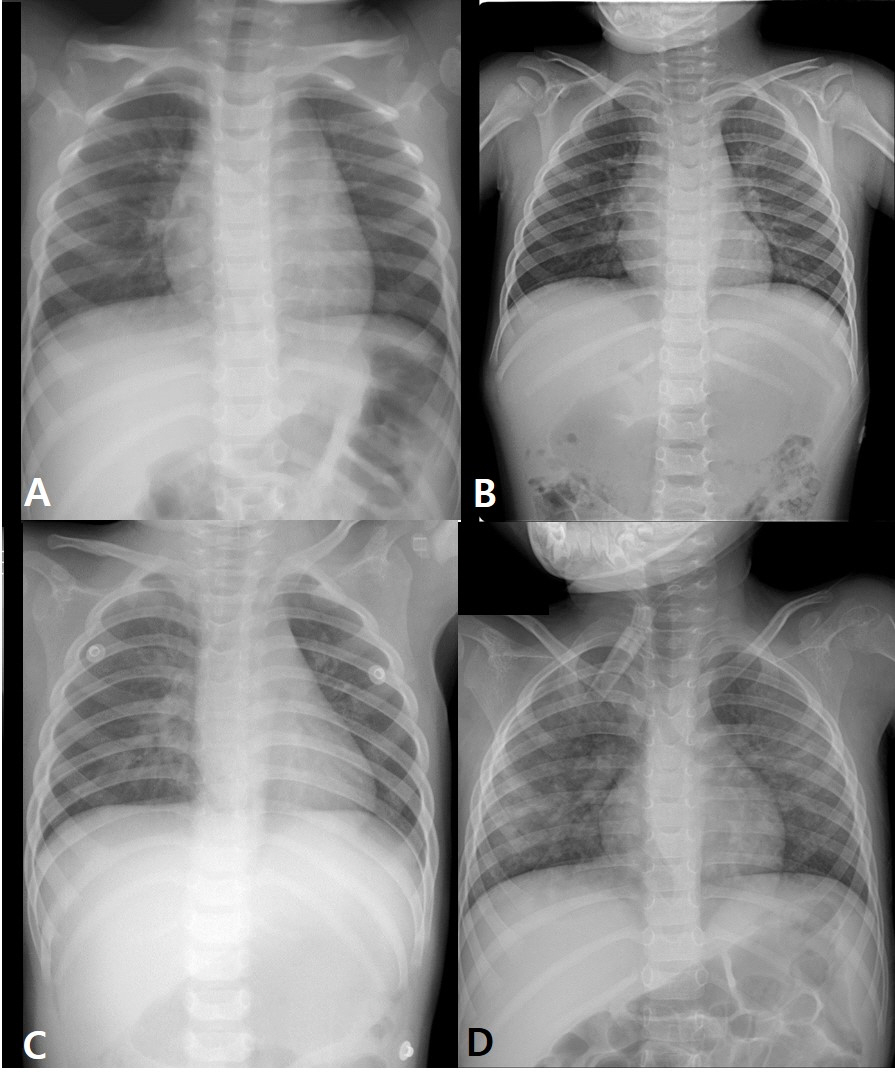Pediatr Emerg Med J.
2021 Dec;8(2):66-72. 10.22470/pemj.2021.00304.
Outcome prediction of pediatric drowning
- Affiliations
-
- 1Department of Pediatrics, Korea University Ansan Hospital, Ansan, Korea
- 2Department of Radiology, Korea University Ansan Hospital, Ansan, Korea
- 3Department of Pediatrics, Korea University Guro Hospital, Seoul, Korea
- KMID: 2523997
- DOI: http://doi.org/10.22470/pemj.2021.00304
Abstract
- Purpose
Despite the well-known mortality of pediatric drowning, there is a paucity of evidence on the implications of an initial evaluation on the relevant outcome of drowning. This study aimed to investigate the association of initial clinical findings with outcome of children undergoing drowning.
Methods
This retrospective study was conducted using the medical records of 56 children undergoing drowning who visited 3 Korean academic hospitals from January 2000 through May 2020. We analyzed information regarding the prehospital resuscitation, drowning time, a 4-tiered chest radiographic grade, and the baseline characteristics. The grade was defined based on the findings of initial chest radiographs. The poor outcomes were defined as the need for intensive care unit care or death aftercare. We analyzed the association of the prehospital resuscitation, submersion time, and the radiographic grade with the poor outcomes using binary logistic regression.
Results
Among the 56 children, 31 (55.4%) were aged 1-4 years. Prehospital resuscitation and 1-5 minutes of submersion time were noted in the 25 (44.6%) and 30 children (53.6%), respectively. The chest radiographic grades 1 through 4 accounted for 17 (30.4%), 20 (35.7%), 12 (21.4%), and 3 children (5.4%), respectively. Poor outcomes occurred in 17 children (30.4%), including 3 deaths (5.4%). The association with the poor outcomes was noted in the submersion time of longer than 5 minutes (adjusted odds ratio, 21.49; 95% confidence interval, 1.11-415.73; compared with < 1 minute) while not in the submersion time and chest radiographic grade.
Conclusion
This study confirms that submersion time is an outcome predictor of drowning.
Keyword
Figure
Reference
-
References
1. Cico S, Quan L. Drowning. In : Tintinalli JE, Ma OJ, Yealy DM, Meckler GD, Stapczynski JS, Cline DM, editors. Tintinalli’s emergency medicine: a comprehensive study guide. 9th ed. New York (NY): McGraw-Hill Educations;2020. p. 1374–6.2. Denny SA, Quan L, Gilchrist J, McCallin T, Shenoi R, Yusuf S, et al. Prevention of drowning. Pediatrics. 2019; 143:e20190850.
Article3. Kim KS, Joung JI, Han MK, Kim BS, Park KY, Lee JJ, et al. Clinical aspects and prognostic factors of near drowning children. J Korean Child Neurol Soc. 2003; 11:322–7. Korean.4. Jeong YT, Oh SH, Lee BS. Prognostic factors related to submerged patients treated at an emergency medical center near a beach. J Trauma Inj. 2003; 16:107–115. Korean.5. Graf WD, Cummings P, Quan L, Brutocao D. Predicting outcome in pediatric submersion victims. Ann Emerg Med. 1995; 26:312–9.
Article6. Jung DB, Kim CH, Kim YB, Cho SH, Cho NS, Yang ES, et al. Analysis of predictive factors in the assessment of near-drowning in children. J Korean Soc Emerg Med. 1998; 9:437–44. Korean.7. Statistics Korea. Korean Statistical Information Service [Internet]. Daejeon (Korea): Statistics Korea;2019 [cited 2021 Oct 29]. Available from: https://kosis.kr/statisticsList/statisticsListIndex.do?vwcd=MT_ZTITLE&menuId=M_01_01#content-group. Korean.8. Bowman SM, Aitken ME, Robbins JM, Baker SP. Trends in US pediatric drowning hospitalizations, 1993-2008. Pediatrics. 2012; 129:275–81.
Article9. Szpilman D. Near-drowning and drowning classification: a proposal to stratify mortality based on the analysis of 1,831 cases. Chest. 1997; 112:660–5.10. Son KL, Hwang SK, Choi HJ. Clinical features and prognostic factors in drowning children: a regional experience. Korean J Pediatr. 2016; 59:212–7.
Article11. El Sibai R, Bachir R, El Sayed M. Submersion injuries in the United States: Patients characteristics and predictors of mortality and morbidity. Injury. 2018; 49:543–8.
Article12. Ho BJ, Crowe JE, Dorfman SR, Camp EA, Yusuf S, Shenoi RP. Correlation of clinical and chest radiograph findings in pediatric submersion cases. Pediatr Radiol. 2020; 50:492–500.
Article13. Suominen P, Baillie C, Korpela R, Rautanen S, Ranta S, Olkkola KT. Impact of age, submersion time and water temperature on outcome in near-drowning. Resuscitation. 2002; 52:247–54.
Article14. Siebke H, Rod T, Breivik H, Link B. Survival after 40 minutes; submersion without cerebral sequeae. Lancet. 1975; 305:1275–7.15. Baek KJ. Clinical analysis of near drowning. J Trauma Inj. 1997; 10:216–23. Korean.16. Migliaccio D. Pediatric drowning. Trauma Reports. 2021; 22:1–16.17. Restrepo CS, Ortiz C, Singh AK, Sannananja B. Near-drowning: epidemiology, pathophysiology and imaging findings. J Trauma Care. 2017; 3:1026.18. Bierens JJ, Lunetta P, Tipton M, Warner DS. Physiology of drowning: a review. Physiology (Bethesda). 2016; 31:147–66.
Article19. van Berkel M, Bierens JJ, Lie RL, de Rooy TP, Kool LJ, van de Velde EA, et al. Pulmonary oedema, pneumonia and mortality in submersion victims; a retrospective study in 125 patients. Intensive Care Med. 1996; 22:101–7.
Article20. Frates RC Jr. Analysis of predictive factors in the assessment of warm-water near-drowning in children. Am J Dis Child. 1981; 135:1006–8.
Article21. Yang JH, Park KN, Choi SP, Kim YM, Kim SK. Clinical analysis of submerged patients treated at an emergency medical center near the Han river. J Korean Soc Emerg Med. 2001; 12:152–9. Korean.22. Kyriacou DN, Arcinue EL, Peek C, Kraus JF. Effect of immediate resuscitation on children with submersion injury. Pediatrics. 1994; 94:137–42.
Article23. Orlowski JP. Drowning, near-drowning, and ice-water submersions. Pediatr Clin North Am. 1987; 34:75–92.
Article24. Woo HO, Park CH. Childhood near-drowning in Chinju. J Korean Pediatr Soc. 1997; 40:1588–95. Korean.25. Cohen N, Scolnik D, Rimon A, Balla U, Glatstein M. Childhood drowning: review of patients presenting to the emergency departments of 2 large tertiary care pediatric hospitals near and distant from the sea coast. Pediatr Emerg Care. 2020; 36:e258–62.
- Full Text Links
- Actions
-
Cited
- CITED
-
- Close
- Share
- Similar articles
-
- Near-Drowning
- Comparison of Pathologic Findings by Seawater or Fresh Water Drowning on the Experimental Animals
- Progress in Method and Reliability of Diatom Test in Drowning
- Evaluation of Sodium and Chloride Biochemical Tests in Drowning Autopsy Cases
- Application of Green Algae Habitating along the Streams in Chungju Province onto the Diagnosis of Drowning


